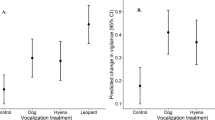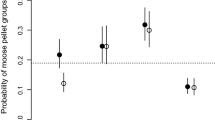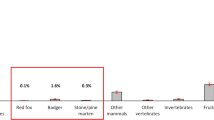Abstract
The mere threat of predation may incite behavioral changes in prey that lead to community-wide impacts on productivity, biodiversity, and nutrient cycling. The paucity of experimental manipulations, however, has contributed to controversy over the strength of this pathway in wide-ranging vertebrate systems. We investigated whether simulated gray wolf (Canis lupus) presence can induce behaviorally-mediated trophic cascades, specifically, whether the ‘fear’ of wolf olfactory cues alone can change deer foraging behavior in ways that affect plants and soils. Wolves were recently removed from the Cedar Creek Ecosystem Science Reserve (Minnesota, USA), such that consumptively mediated predator effects were negligible. At 32 experimental plots, we crossed two nested treatments: wolf urine application and herbivore exclosures. We deployed camera traps to quantify how white-tailed deer (Odocoileus virginianus) adjusted their spatiotemporal habitat use, foraging, and vigilance in response to wolf cues and how these behavioral changes affected plant productivity, plant communities, and soil nutrients. Weekly applications of wolf urine significantly altered deer behavior, but deer responses did not cascade to affect plant or soil properties. Deer substantially reduced crepuscular activity at wolf-simulated sites compared to control locations. As wolves in this area predominantly hunted during mornings and evenings, this response potentially allows deer to maximize landscape use by accessing dangerous areas when temporal threat is low. Our experiment suggests that prey may be sensitive to ‘dynamic’ predation risk that is structured across both space and time and, consequentially, prey use of risky areas during safe times may attenuate behaviorally-mediated trophic cascades at the predator–prey interface.



Similar content being viewed by others
References
Abrams PA (1984) Foraging time optimization and interactions in food webs. Am Nat 124(1):80–96
Atkins JL, Long RY, Pansu J, Daskin JH, Potter AB, Stalmans ME, Tarnita CE, Pringle RM (2019) Cascading impacts of large-carnivore extirpation in an African ecosystem. Science 364(6436):173–177
Bakker ES, Ritchie ME, Olff H, Milchunas DG, Knops JM (2006) Herbivore impact on grassland plant diversity depends on habitat productivity and herbivore size. Ecol Lett 9(7):780–788
Barton K, Barton MK (2018) Package ‘MuMIn’.
Bates D, Maechler M, Bolker B, Walker S (2015) Fitting linear mixed-effects models using lme4. J Stat Softw 67:1–48
Beckerman AP, Uriarte M, Schmitz OJ (1997) Experimental evidence for a behavior-mediated trophic cascade in a terrestrial food chain. Proc Natl Acad Sci 94(20):10735–10738
Benson EJ, Hartnett DC (2006) The role of seed and vegetative reproduction in plant recruitment and demography in tallgrass prairie. Plant Ecol 187:163–177. https://doi.org/10.1007/s11258-005-0975-y
Berger J, Swenson JE, Persson IL (2001) Recolonizing carnivores and naive prey: conservation lessons from Pleistocene extinctions. Science 291(5506):1036–1039. https://doi.org/10.1126/science.1056466
Borer ET, Seabloom EW, Shurin JB, Anderson KE, Blanchette CA, Broitman B, Cooper SD, Halpern BS (2005) What determines the strength of a trophic cascade? Ecology 86(2):528–537. https://doi.org/10.1890/03-0816
Brooks ME, Kristensen K, van Benthem KJ, Magnusson A, Berg CW, Nielsen A, Bolker BM (2017) glmmTMB balances speed and flexibility among packages for zero-inflated generalized linear mixed modeling. R J 9(2):378–400. https://doi.org/10.3929/ethz-b-000240890
Brown JS (1999) Vigilance, patch use and habitat selection: foraging under predation risk. Evol Ecol Res 1(1):49–71
Brown JS, Laundré JW, Gurung M (1999) The ecology of fear: optimal foraging, game theory, and trophic interactions. J Mammal 80(2):385–399. https://doi.org/10.2307/1383287
Callan R, Nibbelink NP, Rooney TP, Wiedenhoeft JE, Wydeven AP (2013) Recolonizing wolves trigger a trophic cascade in Wisconsin (USA). J Ecol 101(4):837–845. https://doi.org/10.1111/1365-2745.12095
Carbone C, Christie S, Conforti K, Coulson T, Franklin N, Shahruddin WN (2001) The use of photographic rates to estimate densities of tigers and other cryptic mammals. Anim Conserv 4(1):75–79
Carpenter SR, Kitchell JF (eds) (1996) The trophic cascade in lakes. Cambridge University Press
Carpenter SR, Kitchell JF, Hodgson JR (1985) Cascading trophic interactions and lake productivity. Bioscience 35(10):634–639. https://doi.org/10.2307/1309989
Chamaillé-Jammes S, Malcuit H, Le Saout S, Martin JL (2014) Innate threat-sensitive foraging: black-tailed deer remain more fearful of wolf than of the less dangerous black bear even after 100 years of wolf absence. Oecologia 174(4):1151–1158. https://doi.org/10.1007/s00442-013-2843-0
Cherry MJ, Conner LM, Warren RJ (2015) Effects of predation risk and group dynamics on white-tailed deer foraging behavior in a longleaf pine savanna. Behav Ecol 26:1091–1099
Cherry MJ, Warren RJ, Conner LM (2016) Fear, fire, and behaviorally mediated trophic cascades in a frequently burned savanna. For Ecol Manag 368:133–139. https://doi.org/10.1016/j.foreco.2016.03.011
Collins SL, Knapp AK, Briggs JM, Blair JM, Steinauer EM (1998) Modulation of diversity by grazing and mowing in native tallgrass prairie. Science 280:745–747. https://doi.org/10.1126/science.280.5364.745
Creel S, Winnie JA Jr (2005) Responses of elk herd size to fine-scale spatial and temporal variation in the risk of predation by wolves. Anim Behav 69(5):1181–1189. https://doi.org/10.1016/j.anbehav.2004.07.022
Cresswell W (2008) Non-lethal effects of predation in birds. Ibis 150(1):3–17. https://doi.org/10.1111/j.1474-919X.2007.00793.x
D’Angelo GJ, Giudice JH (2016) Monitoring population trends of White-tailed Deer in Minnesota. Minnesota Department of Natural Resources, St. Paul, Minnesota, USA. https://files.dnr.state.mn.us/wildlife/deer/reports/harvest/deerharvest_2016.pdf. Accessed 24 May 2019
Donadio E, Buskirk SW (2016) Linking predation risk, ungulate antipredator responses, and patterns of vegetation in the high Andes. J Mammal 97:966–977. https://doi.org/10.1093/jmammal/gyw020
Eberhardt LL (1997) Is wolf predation ratio-dependent? Can J Zool 75(11):1940–1944. https://doi.org/10.1139/z97-824
Estes JA, Palmisano JF (1974) Sea otters: their role in structuring nearshore communities. Science 185(4156):1058–1060. https://doi.org/10.1126/science.185.4156.1058
Estes JA, Terborgh J, Brashares JS, Power ME, Berger J, Bond WJ, Marquis RJ (2011) Trophic downgrading of planet Earth. Science 333(6040):301–306. https://doi.org/10.1126/science.1205106
Fargione J, Tilman D (2005) Niche differences in phenology and rooting depth promote coexistence with a dominant C4 bunchgrass. Oecologia 143:598–606. https://doi.org/10.1007/s00442-005-0010-y
Flagel DG, Belovsky GE, Beyer DE (2016) Natural and experimental tests of trophic cascades: gray wolves and white-tailed deer in a Great Lakes forest. Oecologia 180(4):1183–1194. https://doi.org/10.1007/s00442-015-3515-z
Ford AT, Goheen JR (2015) Trophic cascades by large carnivores: a case for strong inference and mechanism. Trends Ecol Evol 30(12):725–735. https://doi.org/10.1016/j.tree.2015.09.012
Fortin D, Beyer HL, Boyce MS, Smith DW, Duchesne T, Mao JS (2005) Wolves influence elk movements: behavior shapes a trophic cascade in Yellowstone National Park. Ecology 86(5):1320–1330. https://doi.org/10.1890/04-0953
Frank DA (2013) Assessing the effects of climate change and wolf restoration on grassland processes. In: White PJ, Garrott RA, Plumb GE (eds) Yellowstone’s Wildlife in Transition. Harvard University Press, Cambridge, MA, pp 195–208
Frank DA (2008) Evidence for top predator control of a grazing ecosystem. Oikos 117(11):1718–1724. https://doi.org/10.1111/j.1600-0706.2008.16846.x
Grigal DF, Chamberlain LM, Finney HR, Wroblewski DW, Gross ER (1974) Soils of the Cedar Creek Natural History Area. UMN Agriculture Experiment Station, St Paul, MN.
Grovenburg TW, Swanson CC, Jacques CN, Klaver RW, Brinkman TJ, Burris BM, Jenks JA (2011) Survival of white-tailed deer neonates in Minnesota and South Dakota. J Wildl Manag 75(1):213–220
Gude JA, Garrott RA, Borkowski JJ, King F (2006) Prey risk allocation in a grazing ecosystem. Ecol Appl 16(1):285–298. https://doi.org/10.1890/04-0623
Hairston NG, Smith FE, Slobodkin LB (1960) Community structure, population control, and competition. Am Nat 94(879):421–425
Hebblewhite M, Smith DW (2010) Wolf community ecology: ecosystem effects of recovering wolves in Banff and Yellowstone National Parks. In: Musiani M, Boitani L, Paquet PC (eds) The wolves of the world: new perspectives on ecology, behavior, and policy. University of Calgary Press, Calgary, Alberta, pp 69–120
Hebblewhite M, White CA, Nietvelt CG, McKenzie JA, Hurd TE, Fryxell JM, Paquet PC (2005) Human activity mediates a trophic cascade caused by wolves. Ecology 86(8):2135–2144. https://doi.org/10.1890/04-1269
Hintz WD, Relyea RA (2017) A salty landscape of fear: responses of fish and zooplankton to freshwater salinization and predatory stress. Oecologia 185(1):147–156. https://doi.org/10.1007/s00442-017-3925-1
Inouye RS, Allison TD, Johnson NC (1994) Old field succession on a Minnesota sand plain: effects of deer and other factors on invasion by trees. Bulletin of the Torrey Botanical Club, pp 266–276
Isbell FI, Wilsey BJ (2011) Rapid biodiversity declines in both ungrazed and intensely grazed exotic grasslands. Plant Ecol 212:1663–1674. https://doi.org/10.1007/s11258-011-9939-6
Kauffman MJ, Brodie JF, Jules ES (2010) Are wolves saving Yellowstone’s aspen? A landscape-level test of a behaviorally mediated trophic cascade. Ecology 91(9):2742–2755. https://doi.org/10.1890/09-1949.1
Kimble DS, Tyers DB, Robison-Cox J, Sowell BF (2011) Aspen recovery since wolf reintroduction on the northern Yellowstone winter range. Rangeland Ecol Manag 64(2):119–130
Knapp AK, Blair JM, Briggs JM, Collins SL, Hartnett DC, Johnson LC, Towne EG (1999) The keystone role of bison in North American tallgrass prairie: bison increase habitat heterogeneity and alter a broad array of plant, community, and ecosystem processes. Bioscience 49(1):39–50. https://doi.org/10.1525/bisi.1999.49.1.39
Kohl MT, Stahler DR, Metz MC, Forester JD, Kauffman MJ, Varley N, MacNulty DR (2018) Diel predator activity drives a dynamic landscape of fear. Ecol Monogr 88(4):638–652. https://doi.org/10.1002/ecm.1313
Kohn BE, Mooty JJ (1971) Summer habitat of white-tailed deer in north-central Minnesota. J Wildl Manag 35:476–487. https://doi.org/10.2307/3799701
Kotler BP, Brown JS, Hasson O (1991) Factors affecting gerbil foraging behavior and rates of owl predation. Ecology 72(6):2249–2260. https://doi.org/10.2307/1941575
Kronfeld-Schor N, Dayan T (2003) Partitioning of time as an ecological resource. Ann Rev Ecol Evol Syst 34(1):153–181. https://doi.org/10.1146/annurev.ecolsys.34.011802.132435
Kuijper DP, Verwijmeren M, Churski M, Zbyryt A, Schmidt K, Jędrzejewska B, Smit C (2014) What cues do ungulates use to assess predation risk in dense temperate forests? PLoS One 9(1):e84607
Kunkel KE, Pletscher DH (2001) Winter hunting patterns of wolves in and near Glacier National Park. Montana J Wildl Manag 65:520–530. https://doi.org/10.2307/3803105
Lashley MA, Chitwood MC, Biggerstaff MT, Morina DL, Moorman CE, DePerno CS (2014) White-tailed deer vigilance: the influence of social and environmental factors. PLoS ONE 9:e90652
Laundré JW, Hernández L, Altendorf KB (2001) Wolves, elk, and bison: reestablishing the “landscape of fear” in Yellowstone National Park, USA. Can J Zool 79(8):1401–1409. https://doi.org/10.1139/z01-094
Lawson D, Inouye R, Huntly N, Carson W (1999) Patterns of woody plant abundance, recruitment, mortality, and growth in a 65 year chronosequence of old-fields. Plant Ecol 145(2):267–279. https://doi.org/10.1023/A:1009873127360
Lenth RV (2016) Least-squares means: the R package lsmeans. J Stat Softw 69(1):1–33
Lima SL, Dill LM (1990) Behavioral decisions made under the risk of predation: a review and prospectus. Can J Zool 68(4):619–640. https://doi.org/10.1139/z90-092
Loreau M (2010) From populations to ecosystems: theoretical foundations for a new ecological synthesis. Princeton University Press, Princeton, NJ
Makin DF, Payne HF, Kerley GI, Shrader AM (2012) Foraging in a 3-D world: how does predation risk affect space use of vervet monkeys? J Mammal 93(2):422–428. https://doi.org/10.1644/11-MAMM-A-115.1
McLaren BE, Peterson RO (1994) Wolves, moose, and tree rings on Isle Royale. Science 266(5190):1555–1558. https://doi.org/10.1126/science.266.5190.1555
McNaughton SJ, Oesterheld M, Frank DA, Williams KJ (1989) Ecosystem-level patterns of primary productivity and herbivory in terrestrial habitats. Nature 341(6238):142. https://doi.org/10.1038/341142a0
Mech LD, Karns PD (1977) Role of the wolf in a deer decline in the Superior National Forest. Research Paper NC-148. St. Paul, MN: US Dept. of Agriculture, Forest Service, North Central Forest Experiment Station, 148
Mech LD, Peterson RO (2003) Wolf-prey relations. In: Mech LD, Boitani L (eds) Wolves: Behavior, Ecology, and Conservation. University of Chicago Press, pp 131–160
Mech LD, Smith DW, MacNulty DR (2015) Wolves on the hunt: the behavior of wolves hunting wild prey. University of Chicago Press
Mech LD, Isbell F, Krueger J, Hart J (2019) Wolf recolonization failure: a Minnesota case study. Can Field Nat 133(1):60–65. https://doi.org/10.22621/cfn.v133i1.2078
Meredith M, Ridout M (2014) Overlap: Estimates of coefficient of overlapping for animal activity patterns. R Package Version 0.2, 4.
Olff H, Ritchie ME (1998) Effects of herbivores on grassland plant diversity. Trends Ecol Evol 13(7):261–265. https://doi.org/10.1016/S0169-5347(98)01364-0
Osada K, Miyazono S, Kashiwayanagi M (2014) Pyrazine analogs are active components of wolf urine that induce avoidance and fear-related behaviors in deer. Front Behav Neurosci 8:276. https://doi.org/10.3389/fnbeh.2014.00276
Pace ML, Cole JJ, Carpenter SR, Kitchell JF (1999) Trophic cascades revealed in diverse ecosystems. Trends Ecol Evol 14(12):483–488. https://doi.org/10.1016/S0169-5347(99)01723-1
Packard JM (2003) Wolf behavior: reproductive, social, and intelligent. In: Mech LD, Boitani L (eds) Wolves: behavior, ecology and conservation. University of Chicago Press, Chicago, pp 35–65
Paine RT (1966) Food web complexity and species diversity. Am Nat 100(910):65–75. https://doi.org/10.1086/282400
Paine RT (1980) Food webs: linkage, interaction strength and community infrastructure. J Anim Ecol 49(3):667–685. https://doi.org/10.2307/4220
Painter LE, Beschta RL, Larsen EJ, Ripple WJ (2015) Recovering aspen follow changing elk dynamics in Yellowstone: evidence of a trophic cascade? Ecology 96(1):252–263. https://doi.org/10.1890/14-0712.1
Palmer MS, Fieberg J, Swanson A, Kosmala M, Packer C (2017) A ‘dynamic’ landscape of fear: prey responses to spatiotemporal variations in predation risk across the lunar cycle. Ecol Lett 20(11):1364–1373. https://doi.org/10.1111/ele.12832
Parsons MH, Apfelbach R, Banks PB, Cameron EZ, Dickman CR, Frank AS, Sparrow EE (2018) Biologically meaningful scents: a framework for understanding predator–prey research across disciplines. Biol Rev 93(1):98–114
Peacor SD, Werner EE (2001) The contribution of trait-mediated indirect effects to the net effects of a predator. Proc Natl Acad Sci 98(7):3904–3908. https://doi.org/10.1073/pnas.071061998
Peckarsky BL, Abrams PA, Bolnick DI, Dill LM, Grabowski JH, Trussell GC (2008) Revisiting the classics: considering nonconsumptive effects in textbook examples of predator–prey interactions. Ecology 89(9):2416–2425. https://doi.org/10.1890/07-1131.1
Peers MJ, Majchrzak YN, Neilson E, Lamb CT, Hämäläinen A, Haines JA, Boutin S (2018) Quantifying fear effects on prey demography in nature. Ecology 99(8):1716–1723. https://doi.org/10.1002/ecy.2381
Percorella I, Fattorini N, Macchi E, Ferretti F (2018) Sex/age differences in foraging, vigilance and alertness in a social herbivore. Acta Ethologica 22(1):1–8
Peters R, Mech LD (1975) Scent-marking in wolves: a field study. Am Sci 63(6):628–637
Peterson RO, Cucci P (2003) The wolf as a carnivore. In: Mech LD, Boitani L (eds) Wolves: behavior, ecology, and conservation. University of Chicago Press, Chicago, pp 104–130
Pierce RL (1954) Vegetation cover types and land use history of the cedar creek natural history reservation, anoka and isanti counties. University of Minnesota, St Paul, MN Minnesota
Pinheiro J, Bates D, DebRoy S, Sarkar D, R Core Team (2018) nlme: Linear and Nonlinear Mixed Effects Models. R package version 3.1–137
Polis G, Strong D (1996) Food web complexity and community dynamics. Am Nat 147(5):813–846
Preisser EL, Bolnick DI, Benard MF (2005) Scared to death? The effects of intimidation and consumption in predator–prey interactions. Ecology 86(2):501–509. https://doi.org/10.1890/04-0719
Preisser EL, Orrock JL, Schmitz OJ (2007) Predator hunting mode and habitat domain alter non-consumptive effects in predator–prey interactions. Ecology 88(11):2744–2751. https://doi.org/10.1890/07-0260.1
Quenette PY (1990) Functions of vigilance behaviour in mammals: a review. Acta Oecologica 11(6):801–818
R Core Team (2018) R: A language and environment for statistical computing. R Foundation for Statistical Computing, Vienna, Austria
Ridout MS, Linkie M (2009) Estimating overlap of daily activity patterns from camera trap data. J Agric Biol Environ Stat 14(3):322–337. https://doi.org/10.1198/jabes.2009.08038
Ripple WJ, Beschta RL (2007) Restoring Yellowstone’s aspen with wolves. Biol Conserv 138(3–4):514–519. https://doi.org/10.1016/j.biocon.2007.05.006
Ripple WJ, Beschta RL (2012) Trophic cascades in Yellowstone: the first 15 years after wolf reintroduction. Biol Conserv 145(1):205–213. https://doi.org/10.1016/j.biocon.2011.11.005
Ripple WJ, Larsen EJ, Renkin RA, Smith DW (2001) Trophic cascades among wolves, elk and aspen on Yellowstone National Park’s northern range. Biol Conserv 102(3):227–234. https://doi.org/10.1016/S0006-3207(01)00107-0
Ritchie ME, Tilman D (1995) Responses of legumes to herbivores and nutrients during succession on a nitrogen-poor soil. Ecology 76(8):2648–2655. https://doi.org/10.2307/2265835
Ritchie ME, Tilman D, Knops JM (1998) Herbivore effects on plant and nitrogen dynamics in oak savanna. Ecology 79(1):165–177. https://doi.org/10.1890/0012-9658(1998)079[0165:HEOPAN]2.0.CO;2
Russell FL, Zippin DB, Fowler NL (2001) Effects of white-tailed deer (Odocoileus virginianus) on plants, plant populations and communities: a review. Am Mid Nat 146(1):1–26. https://doi.org/10.1674/0003-0031(2001)146[0001:EOWTDO]2.0.CO;2
Schmitz OJ (1998) Direct and indirect effects of predation and predation risk in old-field interaction webs. Am Nat 151(4):327–342. https://doi.org/10.1086/286122
Schmitz OJ (2005) Scaling from plot experiments to landscapes: studying grasshoppers to inform forest ecosystem management. Oecologia 145(2):224–233. https://doi.org/10.1007/s00442-005-0063-y
Schmitz OJ, Beckerman AP, O’Brien KM (1997) Behaviorally mediated trophic cascades: effects of predation risk on food web interactions. Ecology 78(5):1388–1399
Schmitz OJ, Hambäck PA, Beckerman AP (2000) Trophic cascades in terrestrial systems: a review of the effects of carnivore removals on plants. Am Nat 155(2):141–153. https://doi.org/10.1086/303311
Schmitz OJ, Krivan V, Ovadia O (2004) Trophic cascades: the primacy of trait-mediated indirect interactions. Ecol Lett 7(2):153–163. https://doi.org/10.1111/j.1461-0248.2003.00560.x
Shurin JB, Borer ET, Seabloom EW, Anderson K, Blanchette C, Broitman B, Halpern BS (2002) A cross-ecosystem comparison of the strength of trophic cascades. Ecol Lett 5(6):785–791. https://doi.org/10.1046/j.1461-0248.2002.00381.x
Smith JA, Donadio E, Pauli JN, Sheriff MJ, Middleton AD (2019) Integrating temporal refugia into landscapes of fear: prey exploit predator downtimes to forage in risky places. Oecologia 189:883–890. https://doi.org/10.1007/s00442-019-04381-5
Suraci JP, Clinchy M, Dill LM, Roberts D, Zanette LY (2016) Fear of large carnivores causes a trophic cascade. Nat Commun 7:10698. https://doi.org/10.1038/ncomms10698
Suraci JP, Clinchy M, Zanette LY, Wilmers CC (2019) Fear of humans as apex predators has landscape-scale impacts from mountain lions to mice. Ecol Lett 22:1578–1586. https://doi.org/10.1111/ele.13344
Terborgh J, Feeley K, Silman M, Nuñez P, Balukjian B (2006) Vegetation dynamics of predator-free land-bridge islands. J Ecol 94(2):253–263
Thebault E, Loreau M (2003) Food-web constraints on biodiversity-ecosystem functioning relationships. Proc Natl Acad Sci 100:14949–14954. https://doi.org/10.1073/pnas.2434847100
Tilman D (1987) Secondary succession and the pattern of plant dominance along experimental nitrogen gradients. Ecol Monogr 57(3):189–214. https://doi.org/10.2307/2937080
Tilman D, Reich PB, Isbell F (2012) Biodiversity impacts ecosystem productivity as much as resources, disturbance, or herbivory. Proc Nat Acad Sci 109(26):10394–10397
Trussell GC, Ewanchuk PJ, Matassa CM (2006) Habitat effects on the relative importance of trait- and density-mediated indirect interactions. Ecol Lett 9(11):1245–1252. https://doi.org/10.1111/j.1461-0248.2006.00981.x
Werner EE, Peacor SD (2003) A review of trait-mediated indirect interactions in ecological communities. Ecology 84(5):1083–1100. https://doi.org/10.1890/0012-658(2003)084[1083:AROTII]2.0.CO;2
Zanette LY, Clinchy M (2020) Ecology and neurobiology of fear in free-living wildlife. Annu Rev Ecol Evol Syst 51(1):297–218
Acknowledgements
We would like to thank T. Mielke, K. Worm, J. Miller, and the summer interns at CCESR who assisted with experiment deployment and data collection. Funding was provided by the Minnesota Environment and Natural Resources Trust Fund as recommended by the Legislative‐Citizen Commission on Minnesota Resources (LCCMR) and by the U. S. Geological Survey. Any use of trade, firm or product names is for descriptive purposes only and does not imply endorsement by the U.S. Government.
Author information
Authors and Affiliations
Contributions
MSP conceived of the ideas; MSP, FI, and LDM designed the methodology. MSP, CP, and CP collected the data. MSP analyzed the data and led the writing of the manuscript. All authors contributed critically to the drafts and gave final approval.
Corresponding author
Additional information
Communicated by Christopher Whelan.
Supplementary Information
Below is the link to the electronic supplementary material.
Rights and permissions
About this article
Cite this article
Palmer, M.S., Portales-Reyes, C., Potter, C. et al. Behaviorally-mediated trophic cascade attenuated by prey use of risky places at safe times. Oecologia 195, 235–248 (2021). https://doi.org/10.1007/s00442-020-04816-4
Received:
Accepted:
Published:
Issue Date:
DOI: https://doi.org/10.1007/s00442-020-04816-4




